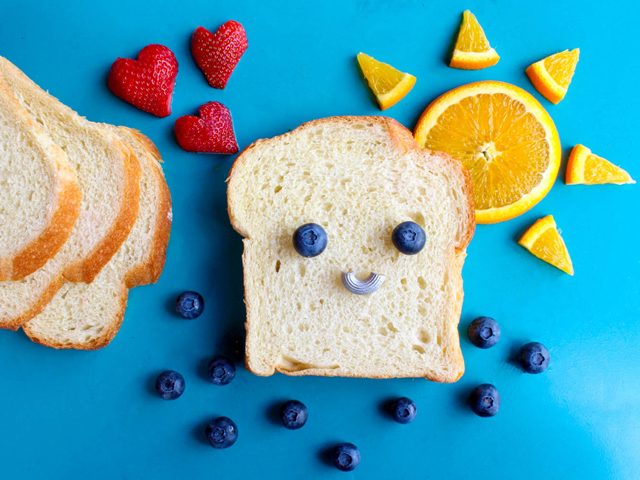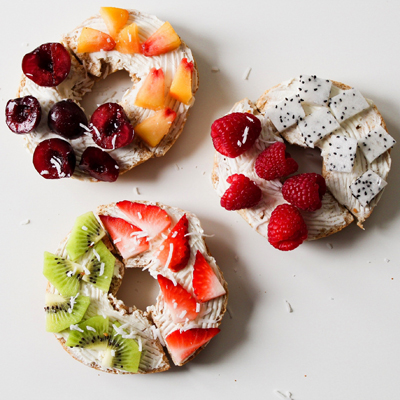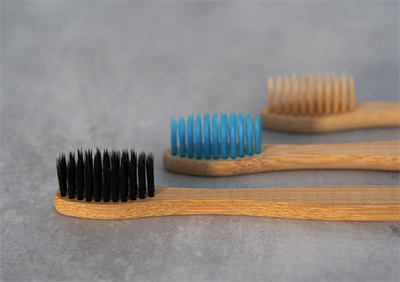Tabitha Acret Lunchbox Snacks Interview

5 Healthy Lunch Box Swaps Your Kids Will Enjoy
As the kids settle back into school routine, the daily grind of lunch box packing begins again. It's stressful, don't get me wrong. Between wrangling the kids in the morning, getting ourselves ready, and constantly reaching for that morning coffee, there's next to no time to think about what you're really putting in their lunch box. It's a mine field of trying to balance health, economics and time. A little extra time prepping on the weekend goes a long way, and reading the back of food labels will save your kids teeth, and overall health from the dangers of hidden sugars.
Here's five healthy lunch box swaps your kids will actually enjoy:
1 – Flavoured yoghurt for Greek yoghurt with fresh fruit
Calcium is great for our children and yoghurt is a healthy snack in itself. Unfortunately, not all yoghurts are created equal in the sugar department. This 'healthy' snack we get our kids can sometimes contain more sugar than soft drink. Stick to the Greek variety or natural yoghurts, and add fresh fruit for flavour rather than the artificially flavoured yoghurts.
2 – Custards and fruit cups for home-made chia puddings
Flavoured custards and fruit cups both contain added sugar with approximately 15 grams per serving, sometimes more. A great swap would be homemade chia puddings with vanilla for flavouring. This reduces the sugar considerably, and provides a nutritious and energetic snack on the heathier side.
 3 – Sandwiches for sushi
3 – Sandwiches for sushi
Swapping white bread and sugary spreads for homemade sushi rolls is a great way to decrease overall sugar content. The process of making sushi rolls is fun for the kids to get involved, and provides a tasty lunch alternate.
4 – Muffins for boiled eggs
The average store bought blueberry muffin contains 36 grams of sugar; this is 11 grams more than the total recommended daily intake for children. Muffins are often advertised as a healthy snack, but to be honest they are simply a cake in an oversized cupcake tin. Hard boiled eggs for example are a great healthy snack for kids – added protein and omega 3's, minus the sugar.
5 – Potato chips for popcorn
Snack chips and biscuit packets can have up to 25 grams of sugar per serving. You may or may not be surprised to learn, this is more than a can of Coke! I can't imagine many parents putting a can of Coke in their 5 year old's lunch box…
However, many parents pack snack sized packets of chips and biscuits, simply because they are not aware of the added sugar content. A great swap is home-made air popped popcorn – fun and tasty.
Interview with Tabitha Acret, Clinical Educator and Dental Hygienist of EMS Dental
Tabitha has 22 years' experience in the dental industry. She graduated from Newcastle University in 2008 with a Bachelor of Oral Health and has since worked in private practice and as a dental educator at Sydney University.
Tabitha has a passion for community dentistry, preventative care and implant maintenance. She has volunteered clinically both within Australia and overseas and volunteers on a regular basis for the Dental Hygienists Association of Australia (DHAA). She is the current DHAA National Vice President, Northern Territory Director and Chair of Continuing Education nationally.
Question: Can you tell us about the hidden sugars in school lunch boxes?
Tabitha Acret: Due to packaging and advertising these days it's often hard to pick healthy options for our children. Labels tend to say "no added sugars" or "organic" and can lead us to assume the product will be a healthier alternative, but on closer inspection these can be the products containing the most sugar. When our children have lunch boxes filled with sugary products at school it can contribute to poor oral health outcomes, but it also causes peaks and troughs in energy levels and generally leads to a "crash" after consuming these products. Inevitably this also leads to a loss of concentration and sometimes behavioral issues at school.
Question: What are the main culprits in school lunch boxes?
Tabitha Acret: Yoghurt, muesli bars and fruit cups are the three main culprits. Whilst yoghurt can be very healthy and a low sugar snack for kids, it's important to check the back of the packet for the hidden sugar content. Our regular yoghurt that we usually buy was sold out recently, when I was looking for an alternate yoghurt I was horrified to read some of the single serve yoghurts had more sugar then a can of Coca-Cola! Muesli bars fall into the same category, they are often covered in sugar or filled with sugar glazed fruits. It's important to check the ingredients and sugar content on the packaging as some of them have the same amount of sugar as a glazed doughnut - most parents I know wouldn't send a glazed doughnut as a daily school lunch box snack. The final culprit is fruit cups. Often the packaging makes claims about being 100% of the recommended daily serving of fruit, and whilst this is technically true, your children are better off having a fresh piece of fruit. Fruit cups are often preserved in sugar syrup and usually contain more sugar in one serving than recommended for your entire daily intake, which is about 25 grams of sugar.
Question: How can parents reduce the sugars in school lunch boxes?
Tabitha Acret: Try to stick to whole foods as much as possible. Check nutrition labels for sugar content and ingredient lists for added sugars and try stick to a daily limit of under 25 grams per day for total sugar intake. That, and always only send water to school.
Question: How does this coincide with the rise of tooth decay?
Tabitha Acret: The mouth naturally contains bacteria, when food high in sugar is consumed these bacteria interact with the excess sugars creating acid. This acid, along with naturally occurring plaque in the mouth, breaks down the hard exterior of the tooth over time – the enamel. Once this enamel has been eroded holes in the teeth can form, these holes are what we call cavities and the whole process is known as decay. Consuming less sugar can help to reduce the acid present in the mouth which in turn helps to prevent decay. Regularly brushing your children's teeth also helps to reduce the presence of plaque, which again aids in preventing decay.
 Question: What are your favorite low sugar options for school lunch boxes?
Question: What are your favorite low sugar options for school lunch boxes? Tabitha Acret: Greek Yoghurt, boiled eggs, cheese, whole fruit, homemade air popped popcorn, raw veggies and cold baked pumpkins and sweet potatoes are all great healthy snacks for the lunch box. These snacks don't take too much time or effort to prep, and provide great low sugar alternatives that are still tasty.
Question: What foods cause the most tooth decay in school-aged children?
Tabitha Acret: Soft drinks, fruit juice, lollies, flavoured milks, cordial, cakes and biscuits are the common culprits. They are the high sugar foods kids beg for despite causing the most decay - flavoured drinks especially. With little to no nutritional value, these snacks should be avoided or kept for special occasions, they're what we call "sometimes foods".
Question: How can parents get their kids caring for their teeth?
Tabitha Acret: It's important that good routines are initiated early so we're setting children up with good oral health care for life. As soon as your children have teeth they need to be brushed with a baby's tooth brush and water. Once your child is old enough to have a go for themselves, then letting them brush (before you re-brush) is a great way to develop these routines. Children do not have the manual dexterity to brush by themselves until around the age of eight.
In our house we use plaque disclosing tablets which are available from local chemists. Not only are these tablets a great motivator, but they help your children directly identify where plaque actually forms, teaching them how to angle their brush into harder to reach areas. Attending the dental practice on a regular basis from a very young age will also help encourage and motivate your children as well as alleviate any fears that may be passed on from parents. It will also aid in identifying any problems very early on. After the oral hygiene check, your dentist or dental hygienist will remove all the bacteria in your mouth with the 'AIRFLOW Dental Spa' using AIRFLOW technology. AIRFLOW is a combination of high pressure air, fine powder and warm water that creates a spray to gently clean your teeth without physically touching them. Imagine a spa treatment but for your mouth!
Interview by Brooke Hunter
Article by Tabitha Acret, Dental Hygienist at AIRFLOW Dental Spa
MORE



